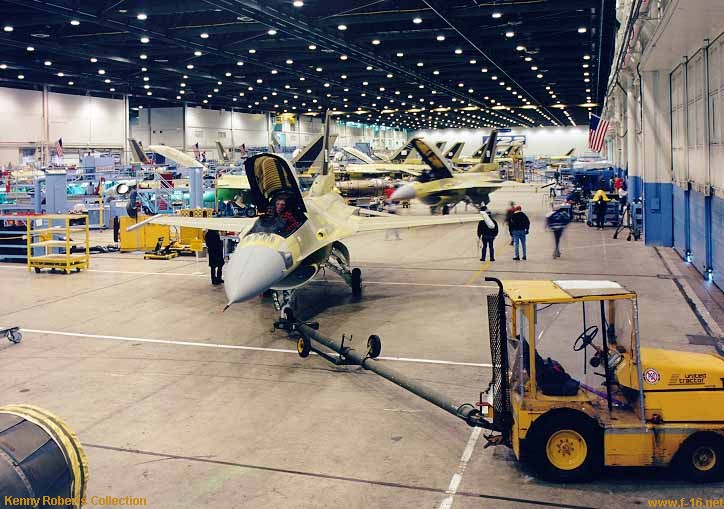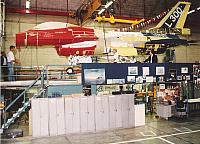Fighter Jet News
F-16 Fighting Falcon News
Production of the F-16 will likely continue through 2020
December 17, 2013 (by
Lieven Dewitte) -
Lockheed Martin has enough orders to keep its F-16 fighter jet production line humming through the third quarter of 2017. They are also pursuing additional orders and upgrades in the Middle East, South America and other markets that would keep the line running through 2020.
Around that time, the cost of Lockheed's new F-35 stealth fighter will have dropped so far that it will make more sense for potential customers to procure F-35s rather than F-16s. Last Friday Lockheed Martin marked completion of its 100th F-35 fighter.
Lockheed has produced over 4,500 F-16s since the program began in 1975, making the F-16 the best-selling fighter jet in history. The jets are flown by 26 countries, including 15 that have placed follow-on orders, Bill McHenry, Lockheed's head of F-16 business development, said in in an interview with Reuters.
The United Arab Emirates is weighing new F-16 orders and possible upgrades, but failed to announce an order at the Dubai air show as some experts had expected.
Lockheed has dramatically scaled back production of the F-16 at its facility in Fort Worth, Texas, to about one plane a month now - from a peak production rate of 30 planes a month in June 1987, said spokesman Mark Johnson. At the moment, the company is completing work on the last one of 20 F-16s it built for Egypt. That jet and seven others are being stored at the Fort Worth plant after the United States announced it would withhold most military aid due to concerns about democracy and human rights.
It is also working on 12 F-16s for Oman, several of which are in varying states of completion at the slimmed-down F-16 production line in Building 8, also known as the "Falcon's Nest," plus a total of 36 jets ordered by Iraq. One of the 145 jets being upgraded for Taiwan is also in the factory, its nose cone already open for insertion of the new Active Electronically Scanned Array (AESA) radar. McHenry said Lockheed saw additional opportunities to upgrade existing F-16s to the new F-16V configuration, which includes the AESA radar, embedded global positioning, updated electronic warfare equipment and avionics systems.
He acknowledged that other companies, including Britain's BAE Systems, were trying to capture some of that upgrade work, but said Lockheed offered lower costs and greater economies of scale given the breadth of its existing work with the 26 countries that already operate the jet. The Pentagon last month approved a deal under which BAE will upgrade 134 older F-16 fighter jets for South Korea, a move that could pressure Lockheed to compete more aggressively in the hunt for upgrade deals.
Lockheed has produced over 4,500 F-16s since the program began in 1975, making the F-16 the best-selling fighter jet in history. The jets are flown by 26 countries, including 15 that have placed follow-on orders, Bill McHenry, Lockheed's head of F-16 business development, said in in an interview with Reuters.
The United Arab Emirates is weighing new F-16 orders and possible upgrades, but failed to announce an order at the Dubai air show as some experts had expected.
Lockheed has dramatically scaled back production of the F-16 at its facility in Fort Worth, Texas, to about one plane a month now - from a peak production rate of 30 planes a month in June 1987, said spokesman Mark Johnson. At the moment, the company is completing work on the last one of 20 F-16s it built for Egypt. That jet and seven others are being stored at the Fort Worth plant after the United States announced it would withhold most military aid due to concerns about democracy and human rights.
It is also working on 12 F-16s for Oman, several of which are in varying states of completion at the slimmed-down F-16 production line in Building 8, also known as the "Falcon's Nest," plus a total of 36 jets ordered by Iraq. One of the 145 jets being upgraded for Taiwan is also in the factory, its nose cone already open for insertion of the new Active Electronically Scanned Array (AESA) radar. McHenry said Lockheed saw additional opportunities to upgrade existing F-16s to the new F-16V configuration, which includes the AESA radar, embedded global positioning, updated electronic warfare equipment and avionics systems.
He acknowledged that other companies, including Britain's BAE Systems, were trying to capture some of that upgrade work, but said Lockheed offered lower costs and greater economies of scale given the breadth of its existing work with the 26 countries that already operate the jet. The Pentagon last month approved a deal under which BAE will upgrade 134 older F-16 fighter jets for South Korea, a move that could pressure Lockheed to compete more aggressively in the hunt for upgrade deals.
Additional images:
Related articles:
Forum discussion:
Tags
- Last Block 50+ F-16 delivered by TAI as part of Peace Onyx IV Program (2012-12-12)
- Lockheed Martin delivers 4,500th F-16 (2012-04-03)
- ()
- U.S. Air Force receives last F-16 (2005-03-25)
- Lockheed Martin Delivers 4,000th F-16 to Egypt (2000-04-28)
- F-16 Fighting Falcon news archive
Forum discussion:
- Start a discussion about this article in the F-16.net forum.
Tags


